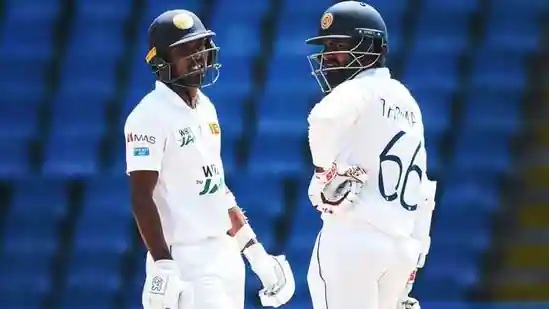
Three wickets in the final session of the day – including a pivotal Kyle Mayers double-strike – ensured that the first Test remained finely poised going into the fourth day, after a 162-run stand between Lahiru Thirimanne and Oshada Fernando had at one point looked like putting Sri Lanka clear.
While Sri Lanka’s lead of 153 with six wickets in hand looks promising on paper, their relatively long tail means a lot depends on Dhananjaya De Silva and Pathum Nissanka – their partnership unbroken on 66 – as well as next-man-in Niroshan Dickwella, the last of Sri Lanka’s recognised batsmen.
The blueprint for what is needed, however, was mapped out earlier in the day by Oshada and Thirimanne, with the pair’s patience having for long periods blunted whatever the hosts threw at them.
That partnership had begun in the sixth over of the innings, after captain Dimuth Karunaratne had edged a wide Kemar Roach delivery to third slip. At that point Sri Lanka, who had picked up the last two West Indian wickets cheaply within the first 15 minutes of the day, were still trailing by 94 runs.
By the time Oshada edged a probing outswinger – falling nine runs short of a second Test century – to become Mayers’ maiden Test wicket, that deficit had transformed to a 68-run lead.
In between, the the pair eschewed all risk and ground down the West Indies bowlers in what was an obstinate yet effective display. And so it needed to be, with the West Indian bowlers who, while visibly tiring, never gave away easy runs. In the absence of swing – at least far less than on the first two days – their bowlers continued to probe outside off. When that didn’t work they briefly switched to some shorter stuff, before going back to the tactics that had proved so successful in the first innings.
But along with the aforementioned lack of swing, the Sri Lankan batsmen too were applying themselves far more adroitly.
A key feature of Oshada’s innings was his use of the feet, whether it was coming down the track to the spin of Rahkeem Cornwall or moving back and across against the seamers. He also used the sweep and reverse sweep liberally, and rather successfully too, on the way to his second Test fifty, though the innings wasn’t without its fair share of fortune. Two early boundaries were undeniably of the streaky variety – both edged through the slip cordon – while a medium-difficulty chance at leg slip after gloving a delivery off Cornwall’s bowling was also grassed by Jason Holder when he was on 16.
Thirimanne meanwhile recorded consecutive 50-plus scores for the first time in his entire Test career, in an innings that reflected the determination of a man that knows he doesn’t have too many chances left to nail down a spot in the side. His boundaries, rare as they were, were nevertheless exquisite in their execution – be it a back foot punch through cover point, or textbook drives through mid-off.
But much of his innings was spent waiting – waiting for the bowlers to bowl to him. He accomplished this by simply refusing to attack deliveries outside off, thus forcing the bowlers to adopt straighter lines. These he would work away either side of the wicket as needed.
Indeed his only misstep was his last, playing marginally down the wrong line to one that seamed back in from Roach coming around the wicket. The timing of that dismissal would also have disappointed him, having come just minutes after Mayers had removed Oshada and Dinesh Chandimal in near-identical fashion.
But fortunately for Sri Lanka, Dhananjaya and Nissanka combined to stave off any further blemishes.

Be the first to comment